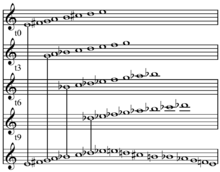
KNOWPIA
WELCOME TO KNOWPIA
Summary
The complexe sonore is an octatonic chord consisting of minor third relations.[1]


More precisely, the complexe sonore is Igor Stravinsky's use of diatonic and whole tone motifs, and scales, against an octatonic background, rotated by minor thirds. Stravinsky "considered them to be in a perpetual state of potential symmetrical rotation by minor thirds under which the octatonic background scale is invariant."[3] Dmitri Tymoczko argues that Stravinsky's octatonicism results "from two other compositional techniques: modal use of non-diatonic minor scales, and superimposition of elements belonging to different scales."[4]
See also edit
References edit
- ^ a b Taruskin, Richard (1996). Stravinsky and the Russian Traditions: A Biography of the Works through Mavra, p.937 and 1394. ISBN 0-520-07099-2.
- ^ Taruskin (2000), p.439.
- ^ Taruskin, Richard (2000). Defining Russia Musically: Historical and Hermeneutical Essays, p.438. ISBN 978-0-691-07065-0.
- ^ Tymoczko, Dmitri (Spring 2002). "Stravinsky and the Octatonic: A Reconsideration" (PDF). Music Theory Spectrum. 24 (1): 68–102. doi:10.1525/mts.2002.24.1.68.


